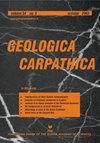U-Pb dating and composition of columbite from Vishteritsa: Implication for timing of granite magmatism and rare-element granitic pegmatites in the Western Rhodopes, Bulgaria
IF 1.5
4区 地球科学
Q4 GEOSCIENCES, MULTIDISCIPLINARY
引用次数: 4
Abstract
The economic significance of pegmatites as a source of strategic rare metals for high-tech products and green energy motivated the present study on Ta–Nb oxides from Vishteritsa rare-element beryl–columbite LCT pegmatites of the Rila–West Rhodopes Batholith in the Western Rhodopes, Bulgaria. Here, we present the first U/Pb age data from columbite with application of the LA–ICP–MS U–Pb technique and a new X36 columbite standard reference material. The obtained Concordia age of 47.57 ± 0.32 Ma with a small spread of the individual 206Pb/238U ages between 45 and 51.3 Ma argues for Early Eocene magmatism and pegmatite formation. The host granite of the rare-element pegmatites is dated 51.94 ± 0.61 Ma with LA–ICP–MS U–Pb technique on zircon and suggests a fertile Early Eocene magmatic period in the Western Rhodopes. EPMA data for the composition of the columbite is used to refine the formula of the mineral (Mn0.554Fe0.427U0.006)0.987(Nb1.826Ta0.085Ti0.116)2.03O6 and define it as columbite-(Mn). Application of the in-situ LA–ICP–MS data technique establishes a series of typical trace elements (Ti, U, Zr, Hf, Y, W, and Zn) that are usually found in content above 500 ppm. The studied columbite is enriched in heavy rare earth elements (HREE sum: 306–697 ppm) and depleted in light REE and Eu. These geochemical characteristics are collectively interpreted as evidence for crystallization from highly fractionated fluid-rich magma. High UO2 content reaching 0.89 wt. % is characteristic for the Vishteritsa columbite. The decrease of U proximal to cracks and in outer crystal zones documents U-mobility during overprinting hydrothermal processes.Vishteritsa柱岩的U-Pb定年和组成:对保加利亚西罗多比花岗岩岩浆作用和稀有元素花岗伟晶岩定年的意义
伟晶岩作为高科技产品和绿色能源的战略稀有金属来源的经济意义,促使本研究对保加利亚西罗多佩地区Rila–West Rhodopes岩基的Vishteritsa稀有元素绿柱石–铌矿LCT伟晶岩中的Ta–Nb氧化物进行研究。在这里,我们应用LA–ICP–MS U–Pb技术和一种新的X36铌矿标准参考材料,提供了铌矿的第一个U/Pb年龄数据。获得的Concordia年龄为47.57岁 ± 0.32 Ma,单个206Pb/238U的小范围分布年龄在45到51.3 Ma之间,说明了早始新世岩浆作用和伟晶岩的形成。稀有元素伟晶岩的主花岗岩的年代为51.94年 ± 用LA–ICP–MS U–Pb技术对锆石进行了0.61 Ma的研究,表明西罗多佩地区存在一个肥沃的早始新世岩浆期。铌矿组成的EPMA数据用于细化矿物(Mn0.554Fe0.427U0.006)0.987(Nb1.826Ta0.085Ti0.116)2.03O6的配方,并将其定义为铌矿-(Mn)。原位LA–ICP–MS数据技术的应用建立了一系列典型的微量元素(Ti、U、Zr、Hf、Y、W和Zn),这些元素的含量通常在500 ppm以上。所研究的铌矿富含重稀土元素(HREE总和:306–697 ppm),贫含轻REE和Eu。这些地球化学特征被共同解释为高度分馏的富含流体的岩浆结晶的证据。UO2含量高,达到0.89wt%。 % 是Vishteritsa铌矿的特征。U在裂纹附近和外部晶体区的减少记录了叠加热液过程中U的迁移率。
本文章由计算机程序翻译,如有差异,请以英文原文为准。
求助全文
约1分钟内获得全文
求助全文
来源期刊

Geologica Carpathica
地学-地球科学综合
CiteScore
2.40
自引率
23.10%
发文量
26
审稿时长
>12 weeks
期刊介绍:
GEOLOGICA CARPATHICA covers a wide spectrum of geological disciplines including geodynamics, tectonics and structural geology, volcanology, stratigraphy, geochronology and isotopic geology, karstology, geochemistry, mineralogy, petrology, lithology and sedimentology, paleogeography, paleoecology, paleobiology and paleontology, paleomagnetism, magnetostratigraphy and other branches of applied geophysics, economic and environmental geology, experimental and theoretical geoscientific studies. Geologica Carpathica , with its 60 year old tradition, presents high-quality research papers devoted to all aspects not only of the Alpine-Carpathian-Balkanian geoscience but also with adjacent regions originated from the Mediterranean Tethys and its continental foreland. Geologica Carpathica is an Official Journal of the Carpathian-Balkan Geological Association.
 求助内容:
求助内容: 应助结果提醒方式:
应助结果提醒方式:


